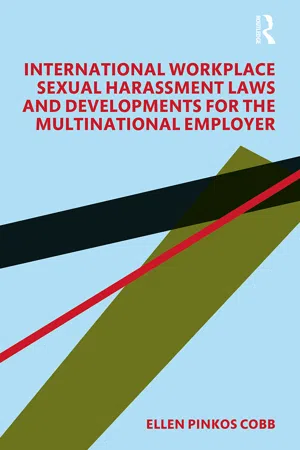
International Workplace Sexual Harassment Laws and Developments for the Multinational Employer
- 264 pages
- English
- ePUB (mobile friendly)
- Available on iOS & Android
International Workplace Sexual Harassment Laws and Developments for the Multinational Employer
About this book
As the #MeToo movement has become an increasingly global and significant workplace matter, a timely resource compiling must-know international workplace sexual harassment laws for the multinational employer is clearly needed.
This book provides a comprehensive compilation of global sexual harassment laws, clearly necessary in this climate but not currently existing until now. It presents legislation addressing workplace sexual harassment in over 50 countries in the European Region, Asia Pacific, Americas, and the Middle East and Africa. Within each region, the laws of individual countries are set forth, as well as some cultural context and recent developments to indicate present and future trends in workplace sexual harassment regulation.
Written in clear, plain English for anyone without a legal background to understand, this book is essential reading and a key resource for employment and business attorneys, global employers, managers, human resources professionals, and occupational health and safety professionals. Academics, practitioners, union members, employees, NGOs, and those in the human rights field will also benefit from this timely resource.
Frequently asked questions
- Essential is ideal for learners and professionals who enjoy exploring a wide range of subjects. Access the Essential Library with 800,000+ trusted titles and best-sellers across business, personal growth, and the humanities. Includes unlimited reading time and Standard Read Aloud voice.
- Complete: Perfect for advanced learners and researchers needing full, unrestricted access. Unlock 1.4M+ books across hundreds of subjects, including academic and specialized titles. The Complete Plan also includes advanced features like Premium Read Aloud and Research Assistant.
Please note we cannot support devices running on iOS 13 and Android 7 or earlier. Learn more about using the app.
Information
1 Workplace sexual harassment
The big picture, the role of culture, and the global view
Sexual harassment basics
- • Sexual harassment is frequently defined as involving unwanted sex-related behavior. While no universal definition exists, most legal understandings include similar elements, such as descriptions of the conduct as unwanted or unwelcome, with the purpose or effect of being intimidating, hostile, degrading, humiliating, or offensive (Source: 14 International Journal of Management Reviews 1, 2, 2011. “Workplace sexual harassment 30 years on: a review of the literature,” by Paula McDonald; 31 Nova Law Review 225, 226–227, 2007. “Directions in sexual harassment law,” by Catharine MacKinnon).
- • Sexual harassment is sex discrimination: many countries regard sexual harassment as sex discrimination, as is shown in this book’s country-by-country legislation. Sexual harassment is not gender-specific, but a large majority of its victims are women.
- • Types of sexual harassment: the two types of sexual harassment are known as “quid pro quo” and “hostile working environment.”
- Sexual harassment is a form of sexual violence that commonly occurs in the world of work, and it is frequently categorized in two ways: “quid pro quo” or “hostile working environment.” Quid pro quo sexual harassment is when a worker is asked for a sexual favour, and submitting to or rejecting that request is used to make a decision about that worker’s job. Hostile working environment harassment covers conduct that creates an intimidating, hostile, or humiliating working environment (Source: International Labour Organization, International Labour Conference, 2018. “Ending violence and harassment against women and men in the world of work”).
Types of workplace laws which include sexual harassment provisions
Impact of workplace sexual harassment
Workplace sexual harassment recognition and prevention by international organizations
A global movement and response of global bodies
- 1) Quid Pro Quo, when a job benefit—such as a pay rise, a promotion, or even continued employment—is made conditional on the victim acceding to demands to engage in some form of sexual behaviour; or;
- 2) Hostile working environment in which the conduct creates conditions that are intimidating or humiliating for the victim.
- PHYSICAL: Physical violence, touching, unnecessary close proximity
- VERBAL: Comments and questions about appearance, lifestyle, sexual orientation, offensive phone calls
- NON-VERBAL: Whistling, sexually-suggestive gestures, display of sexual materials
2019 ILO Convention and Recommendation to Combat Violence and Harassment in the Workplace
- (a) The term “violence and harassment” in the world of work refers to a range of unacceptable behaviours and practices, or threats thereof, whether a single occurrence or repeated, that aim at, result in, or are likely to result in physical, psychological, sexual or economic harm, and includes gender-based violence and harassment;
- (b) The term “gender-based violence and harassment” means violence and harassment directed at persons because of their sex or gender, or affecting persons of a particular sex or gender disproportionately, and includes sexual harassment.
Workplace sexual harassment in a cultural context
Table of contents
- Cover
- Half-Title
- Title
- Copyright
- Contents
- Acknowledgments
- Disclaimer
- Introduction
- 1 Workplace sexual harassment: the big picture, the role of culture, and the global view
- 2 Sexual Harassment in the European Union: the role of dignity and directives
- 3 Sexual harassment laws in European countries
- 4 Sexual harassment laws in the Asia-Pacific region
- 5 Sexual harassment laws in the Americas region
- 6 Sexual harassment laws in Middle East and African countries
- Index